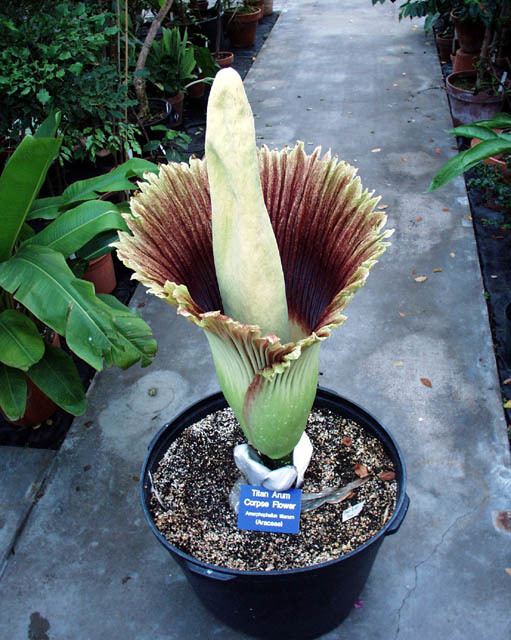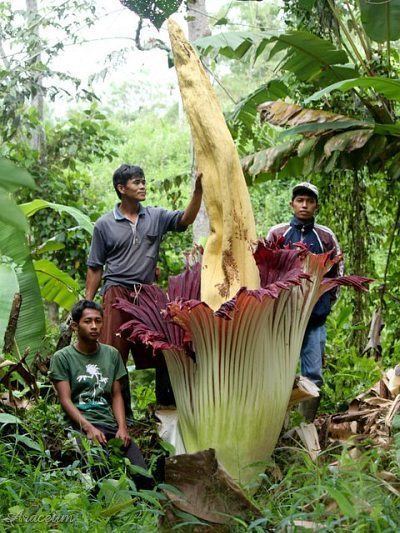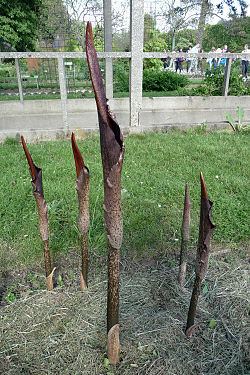Scientific name Amorphophallus Rank Genus | Tribe Thomsonieae | |
Lower classifications Konjac, Titan arum, Elephant Foot Yam, Amorphophallus bulbifer, Amorphophallus preussii | ||
Amorphophallus titanum
Amorphophallus (from Ancient Greek amorphos, "without form, misshapen" + phallos, "penis", referring to the shape of the prominent spadix), commonly known as Zaminkand, is a large genus of some 200 tropical and subtropical tuberous herbaceous plants from the Arum family (Araceae), native to Asia, Africa, Australia and various oceanic islands. A few species are edible as "famine foods" after careful preparation to remove irritating chemicals.
Contents
- Amorphophallus titanum
- Time lapse video amorphophallus titanum 2014 bloom
- History
- Distribution
- Description
- Individual species
- References
Time lapse video amorphophallus titanum 2014 bloom
History

The oldest systematic record of the plants was in 1692, when Van Rheede tot Drakenstein published descriptions of two plants. The name "Amorphophallus" was first mentioned in 1834 by the Dutch botanist Blume. Between 1876 and 1911, Engler merged a number of other genera into Amorphophallus, with a final monograph published in 1911.
Distribution

These are typical lowland plants, growing in the tropical and subtropical zones of the paleotropics, from West Africa to the Pacific Islands. None of them are found in the Americas although a remarkably similar but not closely related genus, Dracontium, has evolved there. Most species are endemic. They grow preferentially on disturbed grounds, such as secondary forests.
Description
These small to massive plants grow from a subterranean tuber. Amorphophallus tubers vary greatly from species to species, from the quite uniformly globose tuber of A. konjac to the elongated tubers of A. longituberosus and A. macrorhizus to the bizarre clustered rootstock of A. coaetaneus. From the top of this tuber a single leaf, which can be several metres across in larger species, is produced atop a trunk-like petiole followed, on maturity, by a single inflorescence. This leaf consists of a vertical leaf stalk and a horizontal blade, which may consist of a number of small leaflets. The leaf lasts one growing season. The peduncle (the primary flower stalk) can be long or short.

As is typical of the Arum family, these species develop an inflorescence consisting of an elongate or ovate spathe (a sheathing bract) which usually envelops the spadix (a flower spike with a fleshy axis). The spathe can have different colors, but mostly brownish-purple or whitish-green. On the inside, they contain ridges or warts, functioning as insect traps.

The plants are monoecious. The spadix has tiny flowers: female flowers, no more than a pistil, at the bottom, then male flowers, actually a group of stamens, and then a blank sterile area. This last part, called 'the appendix', consists of sterile flowers, called staminodes, and can be especially large. There is no corolla.

Once the spathe opens, pollination must happen the same day. In many species, the inflorescence emits a scent of decaying flesh in order to attract insects, though a number of species give off a pleasant odor. Through a number of ingenious insect traps, pollinating insects are kept inside the spathe to deposit pollen on the female flowers, which stay receptive for only one day, while the male flowers are still closed. These open the next day, but by then the female flowers are no longer receptive and so self-pollination is avoided. The male flowers shower the trapped insects with pollen. Once the insects escape, they can then pollinate another flower. Amorphophallus species are used as food plants by the larvae of some Lepidoptera (butterfly and moth) species including Palpifer sexnotatus and Palpifer sordida.
The pollinated flowers then develop a globose berry as a fruit. These can be red, orange-red, white, white and yellow, or blue.
Individual species
The species Amorphophallus titanum, 'corpse flower' or titan arum, is the world's largest unbranched inflorescence, with a height of up to 2.5 m and a width of 1.5 m. After an over 4 feet tall flower opened at Chicago Botanical Gardens on September 29, 2015, thousands lined up to see and smell it. The floriculturalist described it smelling "like roadkill, a barnyard, a dirty diaper, very strong, a little bit of mothball smell too". Native to the Indonesian rainforest it takes 10 years to blossom, to die afterwards. Dubbed "Alice" its bloom was broadcast via live webcam. It is one of two plants at the Botanical Garden, which kept open until 2 am on September 30 to accommodate visitors.
A runner-up is Amorphophallus gigas, which is taller, but has a somewhat smaller flower. Amorphophallus konjac tubers are used to make konnyaku (コンニャク), a Japanese thickening agent and edible jelly containing glucomannan.
Some species are called voodoo lily, as are some species of Typhonium (also in the Araceae).
